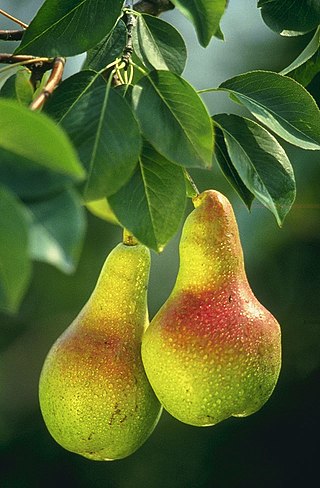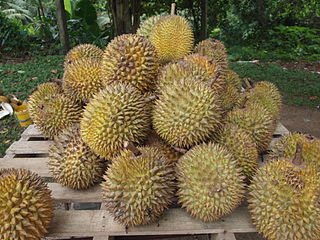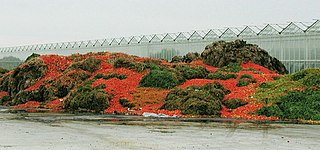
Ethylene is a hydrocarbon which has the formula C2H4 or H2C=CH2. It is a colourless, flammable gas with a faint "sweet and musky" odour when pure. It is the simplest alkene.

Pears are fruits produced and consumed around the world, growing on a tree and harvested in late summer into mid-autumn. The pear tree and shrub are a species of genus Pyrus, in the family Rosaceae, bearing the pomaceous fruit of the same name. Several species of pears are valued for their edible fruit and juices, while others are cultivated as trees.

A banana is an elongated, edible fruit – botanically a berry – produced by several kinds of large herbaceous flowering plants in the genus Musa. In some countries, cooking bananas are called plantains, distinguishing them from dessert bananas. The fruit is variable in size, color, and firmness, but is usually elongated and curved, with soft flesh rich in starch covered with a peel, which may have a variety of colors when ripe. It grows upward in clusters near the top of the plant. Almost all modern edible seedless (parthenocarp) cultivated bananas come from two wild species – Musa acuminata and Musa balbisiana, or hybrids of them.

A mango is an edible stone fruit produced by the tropical tree Mangifera indica. It originated from the region between northwestern Myanmar, Bangladesh, and northeastern India. M. indica has been cultivated in South and Southeast Asia since ancient times resulting in two types of modern mango cultivars: the "Indian type" and the "Southeast Asian type". Other species in the genus Mangifera also produce edible fruits that are also called "mangoes", the majority of which are found in the Malesian ecoregion.

The papaya, papaw, or pawpaw is the plant species Carica papaya, one of the 21 accepted species in the genus Carica of the family Caricaceae, and also the name of its fruit. It was first domesticated in Mesoamerica, within modern-day southern Mexico and Central America. It is grown in several countries in regions with a tropical climate. In 2022, India produced 38% of the world's supply of papayas.

The persimmon is the edible fruit of a number of species of trees in the genus Diospyros. The most widely cultivated of these is the kaki persimmon, Diospyros kaki – Diospyros is in the family Ebenaceae, and a number of non-persimmon species of the genus are grown for ebony timber. In 2019, China produced 75% of the world total of persimmons.

The avocado, alligator pear or avocado pear is a medium-sized, evergreen tree in the laurel family (Lauraceae). It is native to the Americas and was first domesticated in Mesoamerica more than 5,000 years ago. It was prized for its large and unusually oily fruit. The tree likely originated in the highlands bridging south-central Mexico and Guatemala. Avocado trees have a native growth range from Mexico to Costa Rica. Its fruit, sometimes also referred to as an alligator pear or avocado pear, is botanically a large berry containing a single large seed. Sequencing of its genome showed that the evolution of avocados was shaped by polyploidy events and that commercial varieties have an hybrid origin. Avocado trees are partly self-pollinating, and are often propagated through grafting to maintain consistent fruit output. Avocados are presently cultivated in the tropical and Mediterranean climates of many countries. Mexico is the world's leading producer of avocados as of 2020, supplying nearly 30% of the global harvest in that year.
Flavr Savr, a genetically modified tomato, was the first commercially grown genetically engineered food to be granted a license for human consumption. It was developed by the Californian company Calgene in the 1980s. The tomato has an improved shelf-life, increased fungal resistance and a slightly increased viscosity compared to its non-modified counterpart. It was meant to be harvested ripe for increased flavor for long-distance shipping. The Flavr Savr contains two genes added by Calgene; a reversed antisense polygalacturonase gene which inhibits the production of a rotting enzyme and a gene responsible for the creation of APH(3')II, which confers resistance to certain aminoglycoside antibiotics including kanamycin and neomycin. On May 18, 1994, the FDA completed its evaluation of the Flavr Savr tomato and the use of APH(3')II, concluding that the tomato "is as safe as tomatoes bred by conventional means" and "that the use of aminoglycoside 3'-phosphotransferase II is safe for use as a processing aid in the development of new varieties of tomato, rapeseed oil, and cotton intended for food use." It was first sold in 1994, and was only available for a few years before production ceased in 1997. Calgene made history, but mounting costs prevented the company from becoming profitable, and it was eventually acquired by Monsanto Company.

Mangosteen, also known as the purple mangosteen, is a tropical evergreen tree with edible fruit native to Island Southeast Asia, from the Malay Peninsula to Borneo. It has been cultivated extensively in tropical Asia since ancient times. It is grown mainly in Southeast Asia, southwest India and other tropical areas such as Colombia, Puerto Rico and Florida, where the tree has been introduced. The tree grows from 6 to 25 m tall.

Ripening is a process in fruits that causes them to become more palatable. In general, fruit becomes sweeter, less green, and softer as it ripens. Even though the acidity of fruit increases as it ripens, the higher acidity level does not make the fruit seem tarter. This effect is attributed to the Brix-Acid Ratio. Climacteric fruits ripen after harvesting and so some fruits for market are picked green.

Artocarpus odoratissimus is a species of flowering plant in the Moraceae family. It is a commonly called marang, madang, timadang, terap, tarap, kiran, green pedalai, or johey oak. It is native to Borneo, Palawan, and Mindanao Island, and is closely related to the jackfruit, cempedak, and breadfruit trees which all belong to the same genus, Artocarpus.
SmartFresh is a brand of a synthetic produce quality enhancer containing 1-methylcyclopropene (1-MCP). It is marketed by AgroFresh Solutions, Inc., a publicly held (NASDAQ:AGFS) U.S. company with global operations. SmartFresh technology halts the fruits and vegetables' natural ripening process to prolong freshness.

1-Methylcyclopropene (1-MCP) is a cyclopropene derivative used as a synthetic plant growth regulator. It is structurally related to the natural plant hormone ethylene and it is used commercially to slow down the ripening of fruit and to help maintain the freshness of cut flowers.

The durian is the edible fruit of several tree species belonging to the genus Durio. There are 30 recognized Durio species, at least nine of which produce edible fruit. Durio zibethinus, native to Borneo and Sumatra, is the only species available on the international market. It has over 300 named varieties in Thailand and 100 in Malaysia as of 1987. Other species are sold in their local regions.
Generally, fleshy fruits can be divided into two groups based on the presence or absence of a respiratory increase at the onset of ripening. This respiratory increase—which is preceded, or accompanied, by a rise in ethylene—is called a climacteric, and there are marked differences in the development of climacteric and non-climacteric fruits. Climacteric fruit can be either monocots or dicots and the ripening of these fruits can still be achieved even if the fruit has been harvested at the end of their growth period. Non-climacteric fruits ripen without ethylene and respiration bursts, the ripening process is slower, and for the most part they will not be able to ripen if the fruit is not attached to the parent plant. Examples of climacteric fruits include apples, bananas, melons, apricots, tomatoes, as well as most stone fruits. Non-climacteric fruits on the other hand include citrus fruits, grapes, and strawberries Essentially, a key difference between climacteric and non-climacteric fruits is that climacteric fruits continue to ripen following their harvest, whereas non-climacteric fruits do not. The accumulation of starch over the early stages of climacteric fruit development may be a key issue, as starch can be converted to sugars after harvest.

In viticulture, ripeness is the completion of the ripening process of wine grapes on the vine which signals the beginning of harvest. What exactly constitutes ripeness will vary depending on what style of wine is being produced and what the winemaker and viticulturist personally believe constitutes ripeness. Once the grapes are harvested, the physical and chemical components of the grape which will influence a wine's quality are essentially set so determining the optimal moment of ripeness for harvest may be considered the most crucial decision in winemaking.

Post-harvest losses of vegetables and fruit occur at all points in the value chain from production in the field to the food being placed on a plate for consumption. Post-harvest activities include harvesting, handling, storage, processing, packaging, transportation and marketing.

A genetically modified tomato, or transgenic tomato, is a tomato that has had its genes modified, using genetic engineering. The first trial genetically modified food was a tomato engineered to have a longer shelf life, which was on the market briefly beginning on May 21, 1994. The first direct consumption tomato was approved in Japan in 2021. Primary work is focused on developing tomatoes with new traits like increased resistance to pests or environmental stresses. Other projects aim to enrich tomatoes with substances that may offer health benefits or be more nutritious. As well as aiming to produce novel crops, scientists produce genetically modified tomatoes to understand the function of genes naturally present in tomatoes.

Ethylene (CH
2=CH
2) is an unsaturated hydrocarbon gas (alkene) acting as a naturally occurring plant hormone. It is the simplest alkene gas and is the first gas known to act as hormone. It acts at trace levels throughout the life of the plant by stimulating or regulating the ripening of fruit, the opening of flowers, the abscission (or shedding) of leaves and, in aquatic and semi-aquatic species, promoting the 'escape' from submergence by means of rapid elongation of stems or leaves. This escape response is particularly important in rice farming. Commercial fruit-ripening rooms use "catalytic generators" to make ethylene gas from a liquid supply of ethanol. Typically, a gassing level of 500 to 2,000 ppm is used, for 24 to 48 hours. Care must be taken to control carbon dioxide levels in ripening rooms when gassing, as high temperature ripening (20 °C; 68 °F) has been seen to produce CO2 levels of 10% in 24 hours.
Sylvia Blankenship is an American horticulturalist and inventor. She is an emeritus professor at North Carolina State University. She identified 1-methylcyclopropene, a compound which extends the storage life of fruits. Blakenship was inducted into the National Inventors Hall of Fame in 2020.















